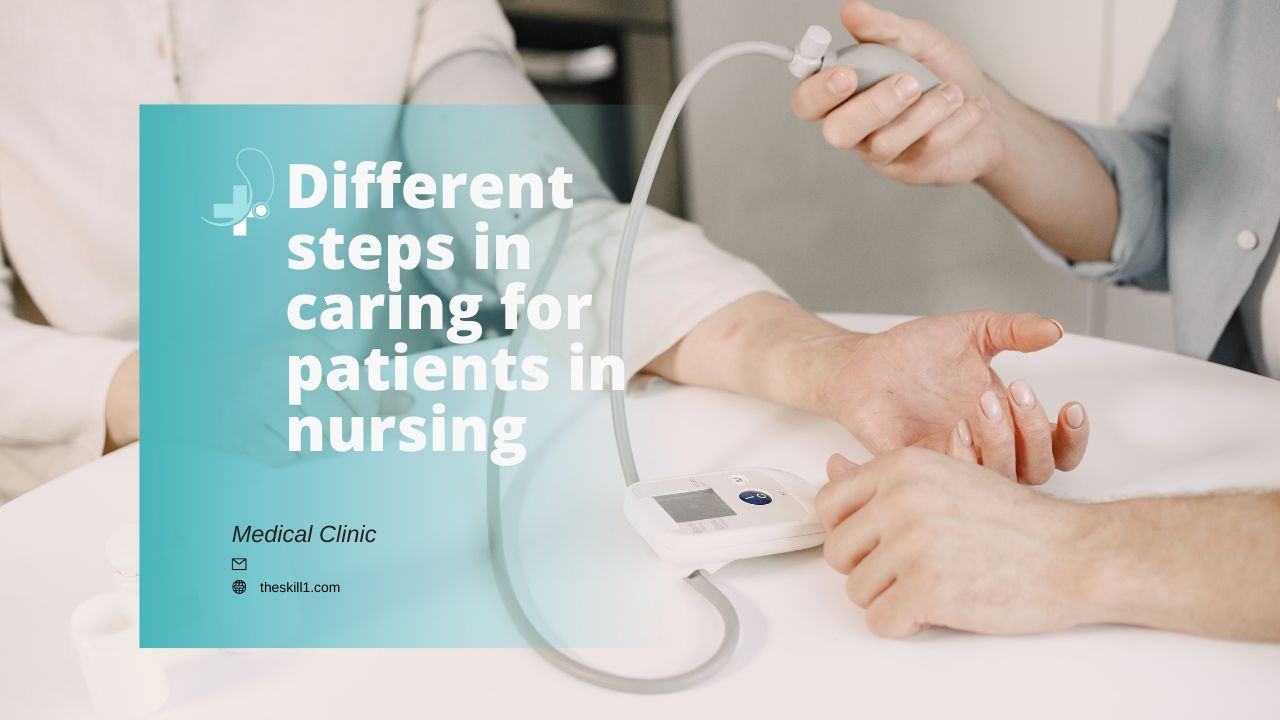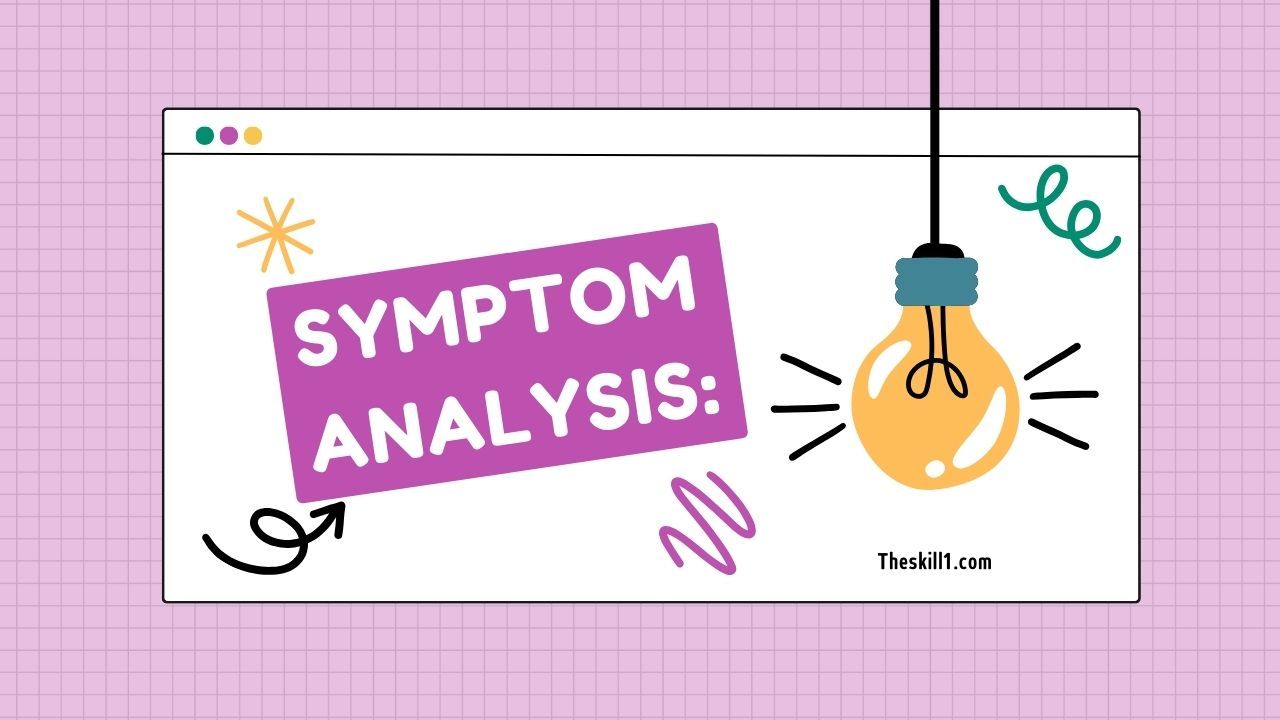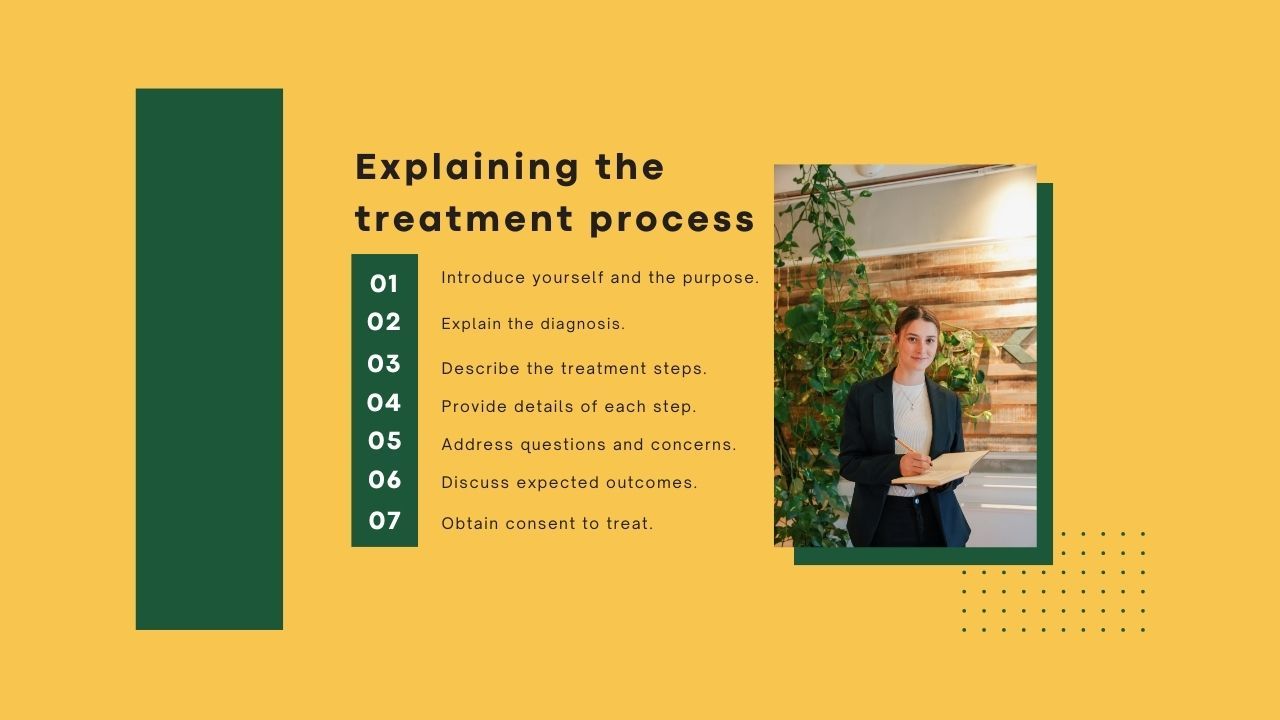


1. Illness history inquiry:
การสอบถามประวัติการเจ็บป่วย: พยาบาลอาจถามคนไข้เกี่ยวกับอาการเจ็บป่วยของพวกเขา เช่น มีอาการอะไรบ้าง ระยะเวลาของอาการ และประวัติการเจ็บป่วยในอดีต.Illness history inquiry: The nurse may ask the patient about their illness, such as what symptoms they have. duration of symptoms and past illness history.
2.Symptom analysis:
การวิเคราะห์อาการ: พยาบาลอาจประเมินอาการของคนไข้ เช่น การวัดความดันโลหิต อัตราการเต้นของหัวใจ หรือการตรวจสอบอาการอื่น ๆ เพื่อให้ข้อมูลในการรักษา.Symptom analysis: The nurse may assess the patient's symptoms, such as measuring blood pressure. heart rate or checking other symptoms to provide information on treatment.
3.Treatment Advice:
การให้คำแนะนำเกี่ยวกับการรักษา: พยาบาลอาจให้คำแนะนำเกี่ยวกับการรักษาหรือยาที่คนไข้ควรทาน และอธิบายวิธีการดูแลตัวเอง. Treatment Advice: The nurse may give advice on treatment or medication that the patient should take. and explains how to take care of yourself.
3.1.Explaining the treatment process:
การอธิบายกระบวนการรักษา: ถ้าคนไข้ต้องรับการรักษาหรือผ่าตัด เพื่อป้องกันความสับสน พยาบาลอาจอธิบายกระบวนการและขั้นตอนที่จะเกิดขึ้น. Explaining the treatment process: If the patient requires treatment or surgery to prevent confusion The nurse may explain the process and steps that will take place.
3.2.Conversations to enhance understanding:
การสนทนาเพื่อเสริมสร้างความเข้าใจ: พยาบาลอาจต้องสนทนาเพื่อเสริมสร้างความเข้าใจและให้กำลังใจคนไข้ โดยเฉพาะในสถานการณ์ที่ร้ายแรง.Conversations to enhance understanding: The nurse may need to have conversations to enhance understanding and support the patient. especially in serious situations.
3.3.Providing information about treatment:
การให้ข้อมูลเกี่ยวกับการรักษา: พยาบาลอาจจะให้ข้อมูลเกี่ยวกับการรักษาที่คนไข้จะได้รับ รวมถึงผลของการรักษาที่คาดว่าจะเกิดขึ้น. Providing information about treatment: The nurse may provide information about the treatment the patient will receive. Including the expected results of treatment.
4.Answering Questions:
การตอบคำถาม: พยาบาลจะตอบคำถามที่คนไข้อาจมีเกี่ยวกับสุขภาพหรือการรักษา และให้ข้อมูลที่ถูกต้อง. Answering Questions: Nurses will answer any questions the patient may have about their health or treatment. and provide correct information.
5.Coordinating with Physicians:
การประสานงานกับแพทย์: พยาบาลอาจต้องประสานงานกับแพทย์เพื่อรายงานสถานะของคนไข้และข้อมูลเกี่ยวกับการรักษา. Coordinating with Physicians: The nurse may need to coordinate with physicians to report patient status and information about treatment.
6.Providing Emotional Support:
การให้กำลังใจ: พยาบาลบางครั้งอาจต้องให้ความสนับสนุนทางอารมณ์แก่คนไข้ที่อาจมีความกังวลหรือเครียด. Providing Emotional Support: Nurses may sometimes need to provide emotional support to patients who may be anxious or stressed.
7.Communicating Needs:
การสื่อสารความต้องการ: พยาบาลอาจสื่อสารความต้องการของคนไข้และช่วยให้พวกเขาได้รับการดูแลที่เหมาะสม. Communicating Needs: Nurses may communicate patients' needs and help them receive appropriate care.



words ( Click เพื่อย่อขยาย )
🔹 Antibiotic - A medicine that helps fight bacterial infections. (ยาปฏิชีวนะ)
- Example: The doctor prescribed an antibiotic to treat the infection. (หมอให้ ยาปฏิชีวนะ เพื่อรักษาการติดเชื้อ)
🔹 Balm - A soothing ointment used for pain relief or healing. (ยาหม่อง)
- Example: She applied some balm to relieve her muscle pain. (เธอทา ยาหม่อง เพื่อบรรเทาอาการปวดกล้ามเนื้อ)
🔹 Bandage - A piece of cloth used to cover a wound or injury. (ผ้าพันแผล)
- Example: The nurse wrapped a bandage around his injured leg. (พยาบาลพัน ผ้าพันแผล รอบขาของเขาที่บาดเจ็บ)
🔹 Cast - A hard protective covering used to immobilize broken bones. (พลาสเตอร์หรือเหล็กที่ใช้ปิดแผลหรือกระดูก)
- Example: He wore a cast for six weeks after breaking his arm. (เขาใส่ พลาสเตอร์ เป็นเวลาหกสัปดาห์หลังจากแขนหัก)
🔹 Catheter - A thin tube used to drain fluids from the body or administer medications. (สายลำเลียง)
- Example: The patient had a catheter inserted after surgery. (ผู้ป่วยมีการใส่ สายลำเลียง หลังการผ่าตัด)
🔹 Crutch - A supportive device used to assist walking when a leg is injured. (ไม้เท้าพยุง)
- Example: She used crutches to walk after her surgery. (เธอใช้ ไม้เท้าพยุง หลังการผ่าตัด)
🔹 Diagnosis - The process of identifying a disease based on symptoms. (การวินิจฉัยโรค)
- Example: The doctor’s diagnosis was that she had a severe flu. (การ วินิจฉัยโรค ของหมอคือเธอเป็นไข้หวัดใหญ่ขั้นรุนแรง)
🔹 Disinfectant - A chemical used to kill harmful microorganisms on surfaces. (สารฆ่าเชื้อ)
- Example: The room was cleaned with disinfectant to prevent infection. (ห้องถูกทำความสะอาดด้วย สารฆ่าเชื้อเพื่อป้องกันการติดเชื้อ)
🔹 Fracture - A break or crack in a bone. (กระดูกหัก)
- Example: She suffered a fracture in her leg after the accident. (เธอ กระดูกหัก ที่ขาหลังจากอุบัติเหตุ)
🔹 Gauze - A thin, loosely woven cloth used to cover wounds. (ผ้าก๊อซ)
- Example: The wound was dressed with sterile gauze. (บาดแผลถูกปิดด้วย ผ้าก๊อซ ที่ผ่านการฆ่าเชื้อแล้ว)
🔹 Injection - A method of administering medicine by inserting a needle into the body. (การฉีดยา)
- Example: The doctor gave him an injection to reduce his pain. (หมอให้ การฉีดยา เพื่อลดความเจ็บปวดของเขา)
🔹 Intensive Care Unit (ICU) - A specialized hospital department for critically ill patients. (ห้องผู้ป่วยหนัก)
- Example: After the surgery, she was moved to the ICU for observation. (หลังจากการผ่าตัด เธอถูกย้ายไปยัง ห้องผู้ป่วยหนัก เพื่อติดตามอาการ)
🔹 Laboratory - A place where medical tests and research are carried out. (ห้องปฏิบัติการ)
- Example: The blood sample was sent to the laboratory for analysis. (ตัวอย่างเลือดถูกส่งไปยัง ห้องปฏิบัติการ เพื่อทำการวิเคราะห์)
🔹 Operating Room - A sterile environment where surgeries are performed. (ห้องผ่าตัด)
- Example: The surgeon and team prepared for the procedure in the operating room. (ศัลยแพทย์และทีมเตรียมพร้อมสำหรับการผ่าตัดใน ห้องผ่าตัด)
🔹 Painkiller - A medication used to relieve pain. (ยาแก้ปวด)
- Example: He was given a painkiller after the operation. (เขาได้รับ ยาแก้ปวด หลังการผ่าตัด)
🔹 Prescription - A written order from a doctor for medication. (ใบสั่งยา)
- Example: The doctor gave her a prescription for antibiotics. (หมอให้ ใบสั่งยา สำหรับยาปฏิชีวนะ)
🔹 Radiology - The branch of medicine that uses imaging technology to diagnose diseases. (รังสีวิทยา)
- Example: The patient had an X-ray done in the radiology department. (ผู้ป่วยได้รับการตรวจเอ็กซ์เรย์ที่แผนก รังสีวิทยา)
🔹 Recovery - The process of returning to normal health after illness or injury. (การฟื้นฟูสุขภาพ)
- Example: Her recovery after the surgery was quicker than expected. (การ ฟื้นฟูสุขภาพ ของเธอหลังจากผ่าตัดเร็วกว่าที่คาดไว้)
🔹 Rehabilitation - The process of restoring someone’s health or abilities through therapy. (การฟื้นฟูสมรรถภาพ)
- Example: He attended rehabilitation to strengthen his leg after the injury. (เขาเข้าร่วมการ ฟื้นฟูสมรรถภาพ เพื่อเสริมความแข็งแรงให้ขาหลังบาดเจ็บ)
🔹 Sanitizer - A substance used to kill germs and disinfect. (น้ำยาฆ่าเชื้อ)
- Example: The hospital provides hand sanitizer at every entrance. (โรงพยาบาลมี น้ำยาฆ่าเชื้อ ไว้ที่ทางเข้าทุกทาง)
🔹 Scalpel - A small, sharp knife used in surgeries. (มีดผ่าตัด)
- Example: The surgeon used a scalpel to make the incision. (ศัลยแพทย์ใช้ มีดผ่าตัด เพื่อกรีดแผล)
🔹 Anxious - Feeling worried or nervous about something. (เป็นทุกข์กังวล)
- Example: He felt anxious before the surgery. (เขารู้สึก เป็นทุกข์กังวล ก่อนการผ่าตัด)






